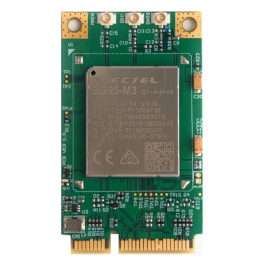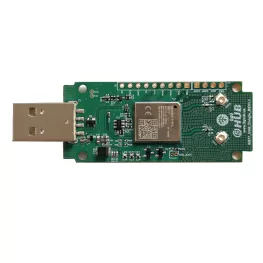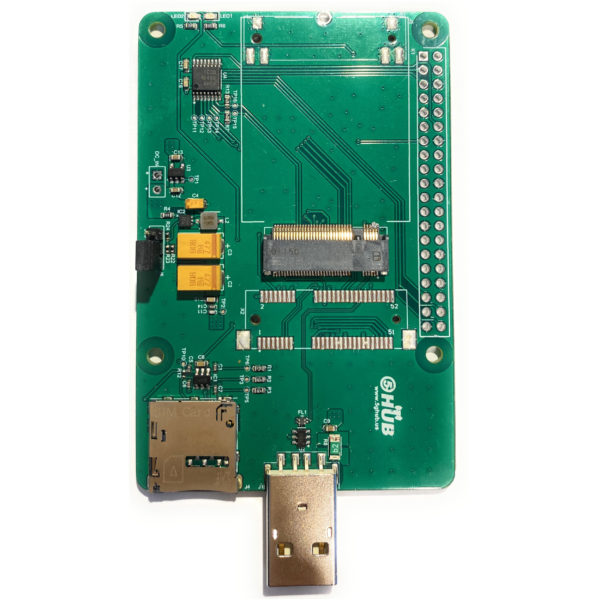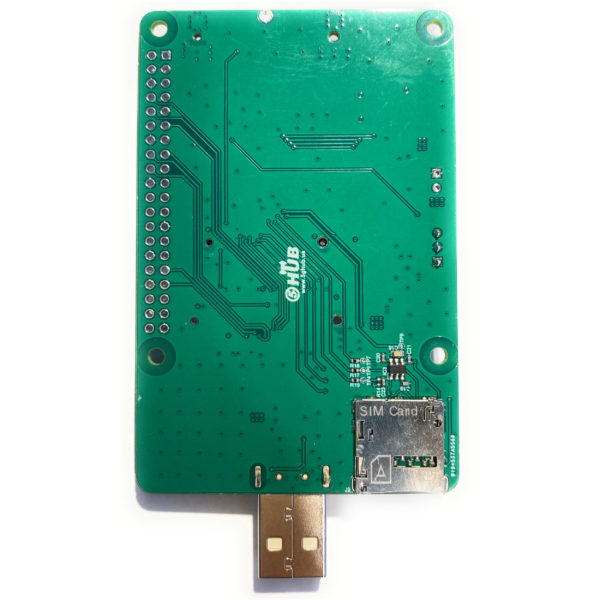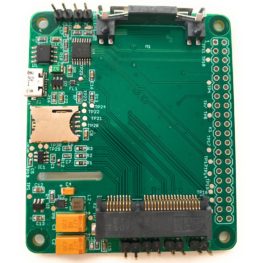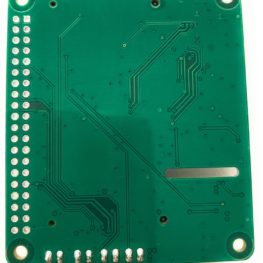Description
The M.2 to USB adaptor hardware board is a rectangular board (about 65x56mm) that can be used with LTE Cat 6/Cat 8/Cat 12 modules. It has four mounting holes in the (nicely rounded) corners and a USB connector that can be plugged into a USB port. It also aligns with the mounting holes on the Raspberry PI B+, has a 40W GPIO header and supports the special autoconfiguration system that allows automatic GPIO setup and driver setup. The automatic configuration is achieved using 2 dedicated pins (ID_SD and ID_SC) on the 40W B+ GPIO header that are reserved for an I2C EEPROM. The EEPROM holds the board manufacturer information, GPIO setup and a thing called a “device tree” fragment – basically a description of the attached hardware that allows Linux to automatically load the required drivers.
The M.2-to-USB adaptor can be used as a standalone adaptor that can be plugged into a USB port. it can be also used with the Raspberry Pi (RP) model B+. The adaptor fits as a HAT (Hardware Attached on Top). A HAT is an add-on board for RP model B+ that conforms to a specific set of rules that will make life easier for users and enable use of different M.2 form factor and hardware LTE Cat 6/Cat 8/Cat 12 chipsets (EM06, EM12) with raspberry PI.
Key Features
The M.2 to USB adaptor has following features:
- Has M.2 interface can be used with LTE Cat 6/Cat 8/Cat 12 modules (EM06/EM12)
- Dual micro SIM card slots making is idea for multiple mobile operators support. The dual SIM card slots can easily be reachable on the upside and downside of the board and switching between the two SIM cards
- Fully compatible with Raspberry Pi models that have the 40-pin GPIO header (4, 3, 2, B+, A+, Zero)
- Easy-to-use, simple setup, plug-and-play
- QMI and PPP are supported
- Clip-in M.2 socket compatible with worldwide LTE/UMTS/HSPA+ and GSM/GPRS/EDGE coverage with regional or global modules which work with different frequencies & carriers
- Supports 4G/LTE module (e.g Quectel EM06 and EM12) that can reach 600 Mbps downlink and 150 Mbps uplink data rates
- Used with 4G/LTE modules that supports Carrier Aggregation (CA)
- Can be used as a standalone with PC/Laptop over USB port, without stacking with Raspberry Pi
- Can be powered from an external 5V source by exposed power pins, directly from Raspberry Pi 5V GPIO headers, or via USB
- HAT can provide adjustable 3.3V or 3.8 V to the M.2 socket
- 2 socket and GPIO support I2C
- The power of the whole board electronics can be disabled for low-power consumption use cases
- The modules (EM06, EM12) have built-in GNSS(GPS/GLONASS) receiver for geo-location applications
- Uses a GPIO connector that spaces the HAT at least 8mm from the Pi (i.e. uses spacers 8mm or larger)
- Conforms to the RP HAT requirements
- Conforms to the HAT mechanical specification
Interfaces
- 2 interface
- USB 2.0 with High Speed up to 480Mbps
- Dual micro USIM card slot
- 40W GPIO to the raspberry PI
Drivers and Raspberry PI
The M.2-USB adaptor does not need or has a driver. Rather, the host computer (such as RPi) needs the driver of the compatible module that will be used with the HAT. For example, if you are using Quectel EM06/EM12 with the HAT, then your host device should have the driver for Quectel modules. Nowadays, most of the Linux kernel comes with the required drivers installed as a result the modules are recognized.
The M.2-USB adaptor is compatible with the following boards. Note that the M.2-USB adaptor can be connected to these board via the USB.
- Raspberry Pi 4, 3, 2, B+, A+, Zero
- Asus Tinker Board
- Rock 64*
- Orange Pi*
- Samsung ARTIK’s Eagleye board
- Latte Panda

